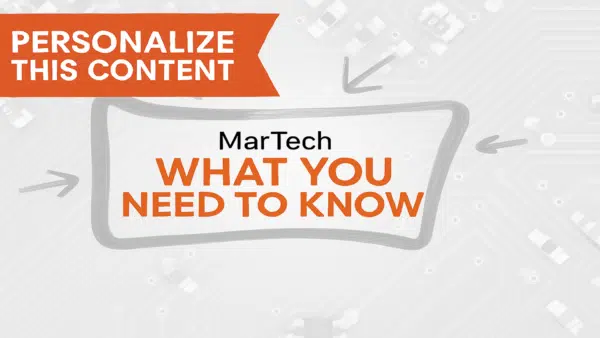B2B marketing
MarTech is your source for B2B marketing content. You’ll find a variety of up-to-date and authoritative resources, including the latest news, tactic-rich tutorials, and the latest data to help you work smarter and make better decisions.
What you read here is written by our experienced in-house team of editors and research professionals, and subject matter experts from leading brands and agencies.
Why we care:
The B2B buyer journey is evolving rapidly as it becomes more digitized, less predictable and more complex. The challenge for B2B marketers is to support what is now a self-guided journey involving numerous personas on accounts and increasingly expanding buying teams. Strategies that were once traditionally B2C are now being adopted by B2B marketers.
Don’t miss out! Get MarTech delivered daily to your inbox. Subscribe for free!
GenAI powers the next era of customer listening
Surveys aren’t enough. Use genAI to detect trends, reveal intent and craft hyper-relevant B2B campaigns informed by true customer voices.
Marketing artificial intelligence (AI)
The latest AI-powered martech news and releases
'The digital afterlife industry' wants to monetize the dead by having your late Aunt Irma ask you for consumer data.
The next era of ABM is strategy-led and AI-enabled
Today’s ABM playbook calls for collaborative execution and contextual engagement that scale impact across the revenue engine.
Marketing artificial intelligence (AI)
Top ways to use Zapier MCP server and LLMs to boost marketing performance
Zapier’s MCP server connects LLMs to thousands of apps, making marketing automation smarter and more efficient.
GTM misreporting is a risk your company can’t afford to take
GTM spend isn’t harmless OpEx. Every dollar of CAC is debt, and misreporting it puts boards and executives at risk.
Marketing artificial intelligence (AI)
ChatGPT traffic to websites is down 52% in a month
Reddit and Wikipedia dominate responses in OpenAI's experiment with answer-first sources using new citation weighting.
Email deliverability: What you need to know
Everything from bulk email requirements to deliverability practices. Updated with what's new about Google’s enhanced DMARC reports.
What if you didn’t follow up on MQLs?
The MQL cycle creates wasted effort and mistrust. Let buyers engage at their own pace for stronger, more meaningful interactions.
A strategic framework for turning small-scale events into ABM wins
Drive deeper account engagement, accelerate pipeline and increase deal size through targeted, intimate ABM events.
Marketing on LinkedIn: What you need to know
Your guide to LinkedIn's tools, strategies and best practices. Updated with information on new Thought Leader Event Ads.
5 things to consider before starting your ABM journey
Your ABM launch shouldn’t be trial and error. These five steps will set up sales alignment and measurable wins from day one.
A short guide to the long game of brand building
Brand building is a multi-year investment in visibility, trust and reputation. And it's more about hustle than ad dollars.
A 3-step copywriting formula that makes buyers take action
Conversions drop when your B2B copy ignores what buyers actually care about. Here’s how to lead with benefits, use cases and proof.
Marketing artificial intelligence (AI)
Reclaiming relevance in an AI-overloaded, buyer-led market
AI saturation is crowding the market. Learn how to cut through the noise, earn trust and connect with today’s buyers.
Why the AI era could be the revenge of the English major
As AI takes over routine work, the valuable marketing skills may no longer be technical. Curiosity, adaptability and leadership will be career essentials.
Why AI-powered relevance is replacing personalization in B2B marketing
Stop chasing names and start targeting buyers ready to buy. AI-powered relevance tools let teams focus content, align with sales and close deals faster.
3 GTM principles to help emerging products gain traction
Early adopters embrace potential. Mainstream buyers demand clarity. The right GTM approach moves products into the mass market.
The hidden power of persona-driven UAT in martech success
Persona-based UAT tests real user journeys, not just individual channels — helping martech teams deliver seamless, customer-first experiences.
How and why awareness, confidence and trust drive GTM outcomes
Most GTM teams chase activity. The best drive causality. ACT — awareness, confidence, trust — fuels revenue, velocity and AI-era visibility.
How a website redesign drove 120+ leads and 1,400% more traffic for a B2B manufacturer
See how strategic content, branding and lead tracking upgrades turned a stagnant website into a growth engine for a contract manufacturer.
Marketing artificial intelligence (AI)
Prompt engineering is dead. Long live context engineering!
Prompt engineering isn't a strategy. To unlock real impact from AI, go-to-market teams must stop scaling improvisation and start engineering context.
Ad fraud is hitting B2B where it hurts: Lead gen
Ad fraud is undermining B2B lead gen through bots, fake data and shady list practices. Here’s how to spot the red flags and protect your funnel.
LinkedIn’s algorithm isn’t broken — you don’t understand it
To stay visible, marketers need to stop blaming the platform and start creating content that earns attention, starts conversations and delivers real value.
Stop celebrating short-term wins that lead to long-term churn
Too many companies close short-term deals that fall apart later. Dan Sperring says they must fix misaligned ICPs and incentivize long-term value to succeed.
Marketing artificial intelligence (AI)
AI’s big bang effect means marketing must evolve or die
AI is reshaping the core of marketing. Staying competitive now means reengineering strategy, structure and leadership—fast.
4 CTV challenges for B2B and how to overcome them
Few B2B brands use CTV — which is exactly why you should. See how smart targeting and creative can build brand and drive pipeline.
Adapting your GTM to win the AI-driven buyer
Buyers don’t browse anymore. They consult AI. Discover how your GTM playbook must evolve to stay visible, relevant and ahead.
How tiered strategies and smart tech are reshaping influencer marketing success
Successful influencer marketing programs are powered by authentic creators, performance-based incentives and technology that tracks results.
AI tools are rewriting the B2B buying process in real time
AI-driven buyers aren’t browsing your gated content — they’re already making decisions. Chris Penn discusses how this shift is leaving sales teams in the dark.
Your go-to-market vendor decisions are now a personal legal risk
Delaware courts expanded fiduciary duty to all officers — making marketing vendor decisions a matter of legal compliance.
How omni-conscious brands win in a buyer-first, fragmented world
When buyers shape the journey, brands must earn every interaction. Here’s how the smartest teams design for trust, not just reach.
Optimization and personalization
What marketers can learn from manufacturing’s shift to precision CX
AI is analyzing decades of manufacturers' customer data to create customer experiences precisely tailored to their different needs.
B2B marketing on X: What you need to know
The advertisers are back, thanks to Elon Musk's relationship with President Trump. But the audience never left -- and that includes B2B buyers.
Your GTM spend isn’t just an expense — it’s an asset
Causal AI brings audit-grade clarity to GTM, enabling a shift from cost-center thinking to asset-based strategy in marketing and sales.
The most underrated B2B channel? Your newsletter
Turn your B2B newsletter into a high-impact, audience-first lead nurture engine that builds trust and keeps your brand top of mind.
B2B buyers want less sales contact
But when B2B buyers do want to engage sales, it's often at critical moments in the process.
Diversity and inclusion in marketing
Brands’ retreat from Pride costs them credibility
Consumers across the political spectrum lose faith in brands that flip-flop on political issues.
Google Ads rolls out AI Max search match type
Google Ads’ new AI Max match type gives visibility into automated search performance for clearer comparisons and more informed campaign decisions.
Why marketing must reclaim GTM design in the age of AI
N.Rich CEO Markus Ståhlberg unpacks the AI-powered GTM shift — and why marketing must lead system design to ensure long-term impact.
FTC says Omnicom deal is OK, as long as there’s no brand safety involved
The world's largest ad agency is forbidden from using 'political or ideological' viewpoints to determine where an ad should run.











































